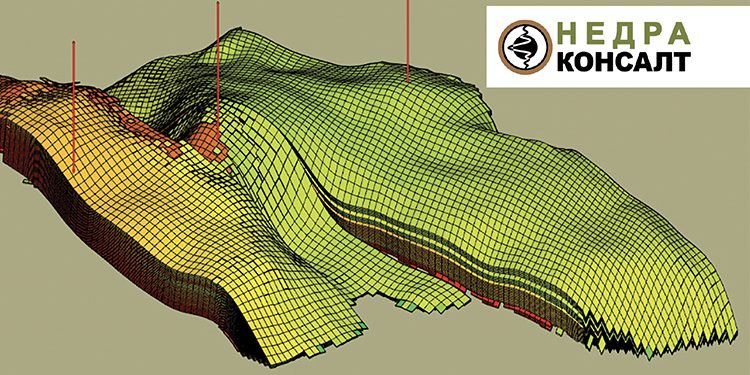Exploring the Resource Potential of the Pre-Jurassic Sedimentary Complex in the West Siberia (Part 2 – Development of the Pre-Jurassic Complex)
Perspectives of the Development of the Basement Rock HC Deposits and Forming a Unified Concept
Considerable amounts of hydrocarbons are accumulated in productive basement sedimentary rocks which makes them attractive development propects during the current trend of reserves deterioration.
However, in spite of the considerable potential of the productive horizons in the basement rocks, the commercial operations of the most of these targets has not been successful.
The deposits complex geological structure, the uncertainty in the knowledge of how the filtration-volumetric characteristics are distributed across cross-sections, the low degree of the available geological information are some of the major complicating factors emerging in the course of the unsuccessful operations in the basement rock productive horizons, the most part of which are of the classic fractured-porous type – the reservoirs are featured with the rock divided by near-vertical fractures. The characteristics of this type of reservoirs, as well as the physical processes taking place inside them, have not been studied in full so far.
Due to the low efficiency of exploration using various available geophysical techniques, the conventional approach to drilling and exploitation of the deposits confined to fractured-porous type reservoirs is inefficient.
Factors that Complicate Development
The analyzed results from drilling in the productive intervals within this type of reservoir, using the example of one of the fields in Tomsk region, indicated that certain risks are involved in drilling through the areas of intense fissuring. Drilling in such zones is coupled with the following problems:
• Loss of drill mud which may become a cause of failure and may lead to a deterioration in the filtration-volumetric characteristics of the bottom-hole formation zone, resulting in a complete failure to further the well’s development and completion;
• Extensive period of time while the open hole remains under the effect of the drilling mud, which causes slides, caving, tight pull and seizure of drilling equipment, as well as other complications.
Drastic drop of formation pressure during well operation has been one the major factors complicating the development of the deposits confined to the pre-Jurassic, due to certain geological aspects, which are vividly demonstrated by the development history of the pre-Jurassic at one of the license areas at the Krasnoleninskoye field, whose exploration has been stopped so far (Fig.1).

The complexity of the analysis lies in the absence of an elaborated system of development, and also in the significant distance between wells. Besides, after a well is shutdown, the pressure build-up in a fissured reservoirs can take place within a few days, and sometimes within a few hours. Due to this, the average measurements of the bottom-hole pressure should be applied in an approximate manner only, because it is practically impossible to determine the actual formation pressure.
The insufficient control of the formation’s pressure variations leads to a reduction in the effectiveness of the reserve recovery management system and to a degrading of the engineering parameters.
The example in the Talin area of the Krasnoleninskoye field, formed by a reservoir with secondary filtration-volumetric properties, showed that signals could be detected from the performance of producing wells at a distance of 5 km, while the development analysis was conducted (Fig. 2).

The given dependency can be vividly traced on the example of wells #1 and #2. After well #2 was commissioned in 1997, the well #1 production rate declined within one month. The flow rate of well#2 drastically increased. As well #1’s flow rate increased, the flow rate at well #2 would decrease. Both wells were shutdown in 2002 due to their low production rates which was caused by a loss in formation pressure (Fig. 3, Table 1).
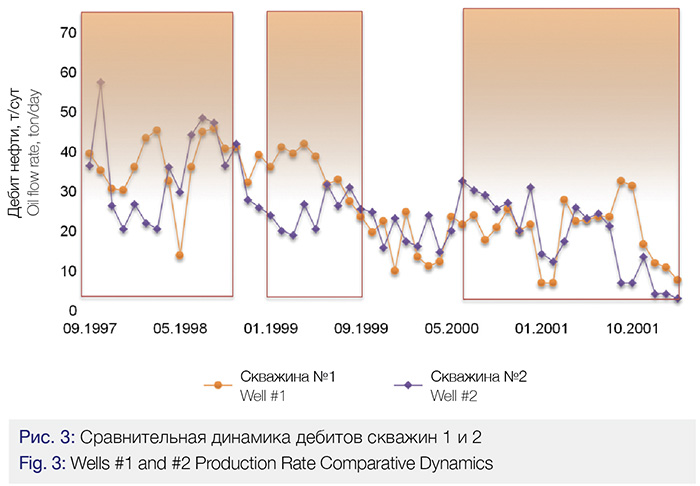

The fact that this is interference in well’s performance highlights the natural macroinhomogeneity, of which a conclusion may be drawn that highly productive wells should be placed in areas with higher fracturing that are located in structural downfolds and highs. This factor, however, in spite of a drastic drop in formation pressure when a well is operated, makes it impossible to implement a formation pressure maintenance system, which is confirmed by the previous unsuccessful attempts of conduction injection operations into such targets (formed by reservoirs of fracturing-porous type) at the fields of the Krasnoleninsky Anticline [11]. Therefore, to prevent formation pressure drop while a well is operated, some optimum operation modes need to be tried out for producing wells, or they need to be placed into intermittent operation.
Since productive zones are unevenly distributed across the area of development targets, confined to the pre-Jurassic complex deposits, enhanced oil recovery methods need to be applied to extend the reserves recovery area. Whatever paradoxically it may seem but it is the hydraulic formation fracturing that becames one of the most effective geological and technical activities, carried out at the pre-Jurassic complex productive deposits.
The results of three frack jobs performed in the M1 formation, at one of the fields in the Tomsk region, highlighted the significant efficiency of the stimulation conducted in reservoirs with low permeability (2 to 5 mD) (Table 2), which is, first of all, due to the fact that hydraulic fracturing results in developing an induced fracturing system associated with the natural formation fracturing, which, in the end, increases well productivity.
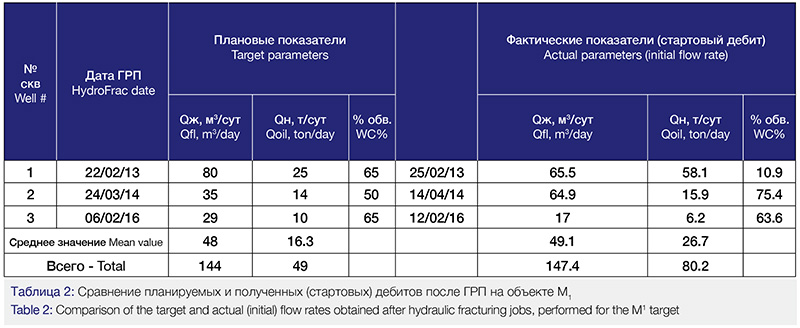
A number of geologic and technological factors which had a significant influence on field development were discovered during the analysis for recovery of the reserves, confined to deposits with secondary filtration-volumetric characteristics.
Approach to Hydrodynamic Simulation of the Pre-Jurassic Deposits
To formulate an effective reserve development conception, aside from the interpretation of the data related to the recovery of the deposits like these, it is necessary to develop a geological and engineering model which would take into account all the irregularities of the geological structure and would make it possible to properly model the physical processes going on subsurface, as well as correctly simulating the production history.
The key moment in creating the model of the pre-Jurassic deposits is the simulation of the geological basis which would reflect the complex voids. The dual porosity and dual permeability model more realistically reflects the effect that the carbonate interlayers have on the fluid production process.
To describe the voids in the dual porosity and dual permeability model, the lithofacial modeling is carried out with reference to three types of reservoirs (porous, fractured, porous-fissured) (Fig.4).
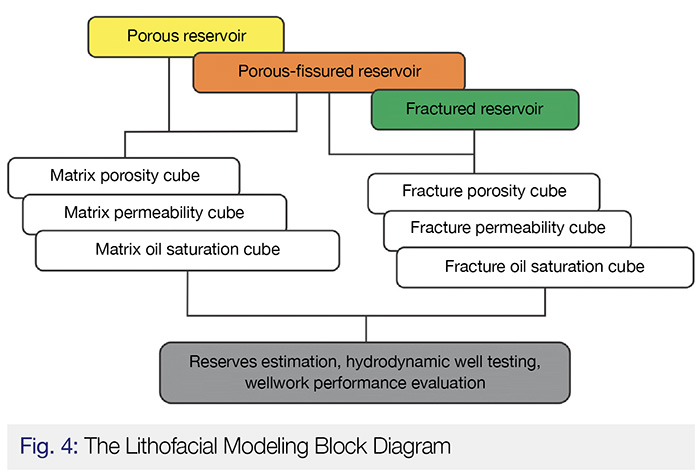
Based on the results of the analysis of the tectonic stress in the area, some analog fields, as well as seismic survey data, a fracture system conceptual model is developed which takes into account the principal direction and spacing of fractures. Then, using the data obtained from wells directly (such as, core samples, complex geophysical surveys, Formation Microimagers), individual properties can be determined, such as the length, the height, the aperture (opening), the intensity and the density of their spacing. Taking into account these individual characteristics, a decision can be made with regard to selecting an approach to simulation of the fracture network in that geological model.
There are two flagship approaches to simulating fractures in a model:
1. Continuous fracture network (CFN)
2. Discrete fracture network (DFN)
The approach using the continuous fracture network (CFN) is featured with the presence of the matrix-like and fissured structures. This approach, in most cases, is applied when there is insufficient information available to describe the fissured structure (for instance, the exploration phase). The fracture system is displayed here as a continuous medium and the individual characteristics of fractures are not taken into account. One of the drawbacks of such approach is that the individual geometric properties and the filtration-volumetric characteristics of fractures are not taken into account and a greater part of a reservoir, compared to the reality, is being drained according to such model. Another minus of this approach is that the uncertainties, related to the fractures geometry and their orientation, are also not considered.
With discrete fracture networks (DFN) a more complex fracture simulation technique makes it possible to simulate several systems. The fractures are simulated according to their geometry and the fluid filtration channels they provide. Using this approach, one can simulate fractures as associated or isolated.
Thus, the approach using a discrete fracture system provides a more realistic simulation of a fissured structure, since it takes into account individual characteristics such as orientation and geometry which, in turn, control fluid filtration.
After a discrete fracture network is built up, the network data is upscaled over the model grid area which results in cubes of filtration-volumetric characteristics as the output data, as well as a sigma-factor cube which is responsible for the fluid interchange between the matrix and a fracture. These cubes, including the reservoir rock matrix, are used for the further build-up of a simulation model.
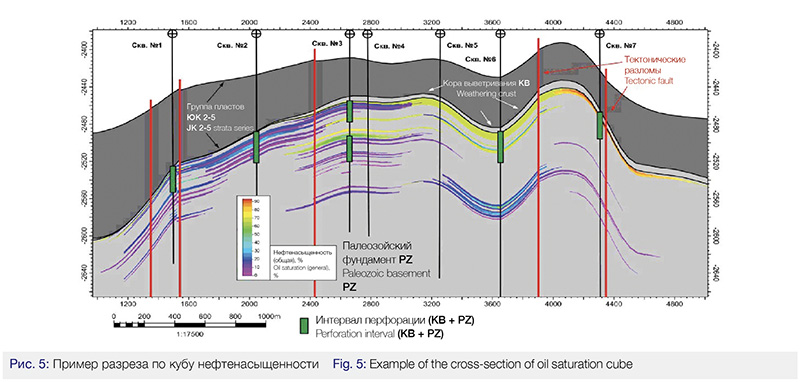
Figure 5 presents a cross-section of the common cube of the Paleozoic basement reservoir oil saturation where oil saturation of each simulated medium (matrix and fractures) is taken into account.
The model of “complex” reservoir provides detailed understanding of the hydrocarbon filtration mechanism in reservoirs with secondary filtration-volumetric properties.
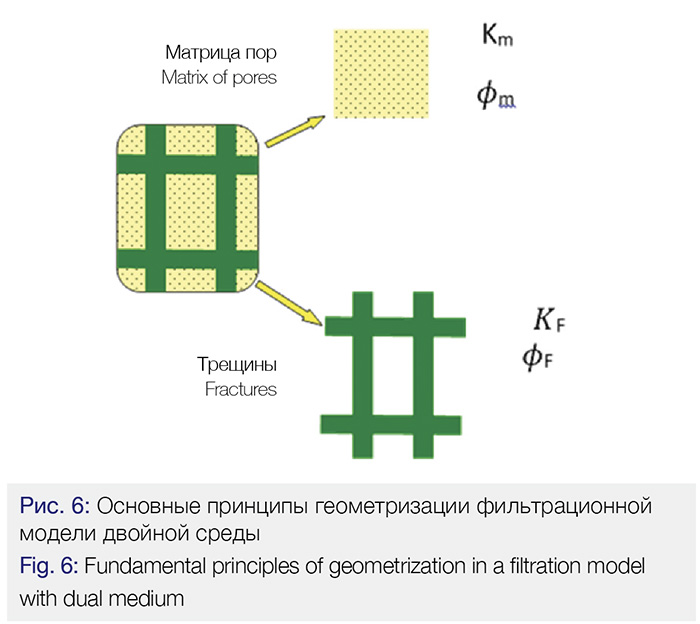
The fluids of the system under consideration exist in the two interrelated blocks (Fig.6) [2]:
• In the rock matrix occupying the major part of a formation;
• In the highly permeable rock fractures.
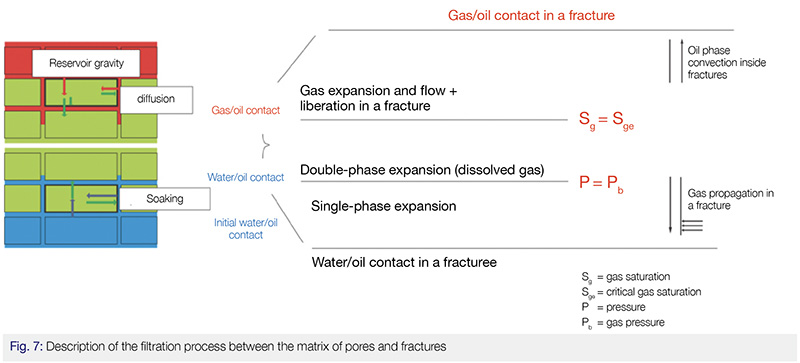
Production from the matrix blocks can be carried out using various physical mechanisms (Fig.7):
• Oil expansion;
• Saturation;
• Gravity saturation/drainage;
• Diffusion;
• Viscosity displacement.
The most part of hydrocarbons in a dual porosity system are contained in the matrix block, while the filtration to wells takes place through the high-permeable fractures [3].
Application of the Wavelet Decomposition Method for Permeability Build-up in Filtration Simulation
Since it is impossible to build-up the permeability of the matrix of pores in a formation using standard methods, let us, using the example of the filtration model sector with secondary filtration-volumetric characteristics, consider the possibility of building up the permeability using the wavelet decomposition method. The wavelet decomposition method takes into account the structural component and it is sufficiently informative and efficient tool for surface analysis, capable of simulating surfaces using different scales, thus, making it possible to reflect both minor and major local structural variations.
Besides, the permeability build-up using the wavelet decomposition method is more efficient in comparison with the method suggested by Murray, since it mostly depends on the structural component and not on directional survey, which results in lower “noise pollution” [4].
A wavelet transform is understood as decomposition of a signal according to the principle of wavelet functions, each of which is shifted and scaled (contracted or stretched). In terms of wavelet coefficients, a wavelet decomposition can be presented as
![]()
(1)
where cAi – are the decomposition depth approximation coefficients i; cDi – are the extending coefficients of decomposition depth i.
Wavelet transform function – finding coefficients
![]()
In our case, the algorithm of the matrix wavelet decomposition can be displayed using the following scheme (Fig.8).
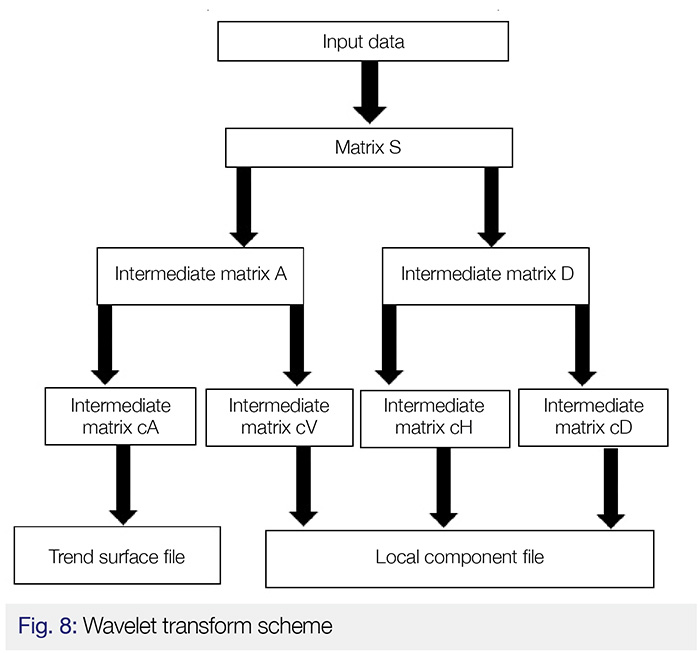
Assume ![]() – is the matrix whose item values conform with the values in the nodes of the grid area of the hydrodynamic model simulating a formation structural surface map. Assume we have the number of nodes N X-directionally, and M is their number Y-directionally. As a result, we obtain the following matrices: cA – are averaged values of the initial structure surface map, refining the following coefficients: cV – “vertically”; cH – “horizontally”; cD – “diagonally” [15].
– is the matrix whose item values conform with the values in the nodes of the grid area of the hydrodynamic model simulating a formation structural surface map. Assume we have the number of nodes N X-directionally, and M is their number Y-directionally. As a result, we obtain the following matrices: cA – are averaged values of the initial structure surface map, refining the following coefficients: cV – “vertically”; cH – “horizontally”; cD – “diagonally” [15].
The permeability simulation was carried out based on the normalization of Level 3 wavelet map according to linear dependence on the amplitude (Fig.9):
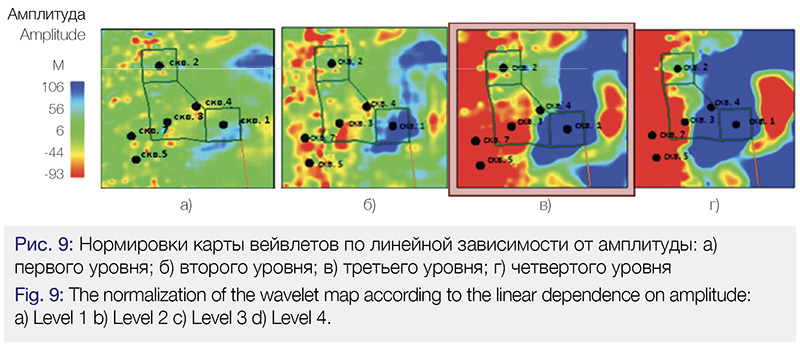
![]() (2)
(2)
where k – is absolute permeability (mkm2), Z– is an amplitude value of the wavelet decomposition map (m).
The application of wavelet functions made it possible to appropriately reproduce the dynamics of well operation, and after the model is adapted it would enable the prediction of initial flow rates and production decline rates in the entire target area, based on the calculation of a test item in the sector (Fig.10).

The Development Concept
Analyzing the exploration and production data and the outcomes of the filtration simulation, it was revealed that the wells with high production rate were located in the downfolded and elevated areas, mostly characterized with natural fracturing.
To successfully develop and operate the hydrocarbon deposits of this kind it is necessary to carry out a set of studies that would allow us to predict the development of naturally fractured zones:
• Seismic prediction of zones of fissure spread (highly productive zones);
• Geomechanic surveys and oriented coring, to determine the rock stress state;
• Carrying out of geophysical and hydrodynamic surveys (build-up curve, observation well testing) to detect the presence and direction of the natural fracture development.
Locating natural fracturing zones would make it possible to define the most productive zones – the ones penetrated with a network of fractures, for placing in them projected wells that would have the maximum production rates and economic efficiency.
Thus, based on the obtained outcomes we can formulate the following general concept for the development and exploitation of deposits associated with the occurrences of pre-Jurassic age, which consists in the following:
• Developing an exploration program aimed at locating zones of naturally developed fracturing.
• Abandoning the rectangular and line-drive systems, transition to selective systems in the design, due to specifics of geological structure and nonuniform distribution of reserves and productive zones all over an area.
• Selecting optimal spacing between wells, taking macrofracturing into account.
• Selecting a technology of tapping productive formations consisting in underbalanced and balanced drilling horizontal wells using light weight drilling muds, to mitigate the hazards of failures and lost circulation.
• Carrying out multi-stage hydraulic fracturing of formation (creating the system of induced fractures of formation to increase well productivity), treating well bottom-hole zone with chemical reagents.
• Intermittent well operation in sparing mode, to provide pressure build-up.
CONCLUSIONS (HC FIELD DEVELOPMENT):
1. Considerable volumes of hydrocarbon reserves in the productive basement rocks make them attractive for further development.
2. Complicated and nonhomogeneous geologic structure and uncertainty in distribution of the filtration-volumetric characteristics of cross-section determine the low degree of geological and geophysical knowledge of it and makes the conventional methods of drilling and deposit exploitation ineffective.
3. Tapping zones of intense fracturing entails risks associated with failures and lost circulation, due to which further development of wells may become impossible.
4. One of the negative factors, making the development of productive deposits of pre-Jurassic more complicated, is sudden drop in formation pressure.
5. Impossibility to implement a formation pressure maintenance system, due to macrofracturing, demands either trying-out of optimum operation modes for producing wells, or intermittent well operation to prevent depletion of the energy potential of an occurrence.
6. The use of formation hydraulic fracturing, as one of the key methods to enhance oil recovery, to create a network of induced fractures, associated with natural fracturing of a formation, and as a result of this, to achieve increasing well productivity.
7. To elaborate a successful concept for development, the model of dual porosity and dual permeability is selected, providing a detailed understanding of the hydrocarbons filtration mechanism in the formations having secondary filtration-volumetric characteristics.
8. Due to the fact that core studies and well logging used to determine the filtration-volumetric properties do not bring satisfactory results, the permeability build-up in the filtration model using the wavelet decomposition method is applied, which takes into account local components of the structural surface.
9. The wavelet analysis method enables appropriate reproducing the dynamics of well operation, and after its adaptation it provides the possibilities to predict initial flow rates and production decline rates in the entire target area.
10. To successfully develop and exploit the hydrocarbon occurrences of productive basement sedimentary rocks, a set of studies is required that would make it possible to predict the development of natural fracturing zones, characterized by the high productivity, to place in them projected wells which would have the maximum production rates and economic efficiency.
11. The development of a general conception of prospecting, exploration and development of the basement rock productive deposits would make it possible to not only involve prospective and attractive resources into development, but would possibly formulate the general principle for development of various productive sediments associated with the reservoirs of complex geologic media having secondary filtration-volumetric characteristics.
References
1. S. A. Skryleev. Experience and Issues of Exploration and Development of the Bazhenov and Abalaka Suite Oil Deposits (on the example of the Em-Yegovskaya area of the Krasnoleninskoye field), 2011.
2. Series of lectures «Naturally Fractured Reservoirs”, part 1, Moscow, 2010, pp.5-7;
3. T. D. Van Golf-Racht. Fundamentals of Fractured Reservoir Engineering., Moscow, Nedra Publishing House, 1986, pp. 93-95
4. L. S. Brilliant, M.A.Antipin, O.Yu.Myasoyedova. Development of the Remaining Oil-in-Place Reserve Localization Methods (wavelet decomposition method), 2011.
5. V. P. Vorobyev, V.G.Gribunin. Theory and Practice of the Wavelet Transform Method // St.Petersburg, VUS Publishing House, 1999, p.204.
Authors:
Evgeny Popov – Executive Director (Nedra-Consult LLC)
Yuri Stovbun – Deputy Chief Geologist
(Nedra-Consult LLC)
Anastasia Russkih – Head of the Hydrodynamic Modeling Department (Nedra-Consult LLC)

